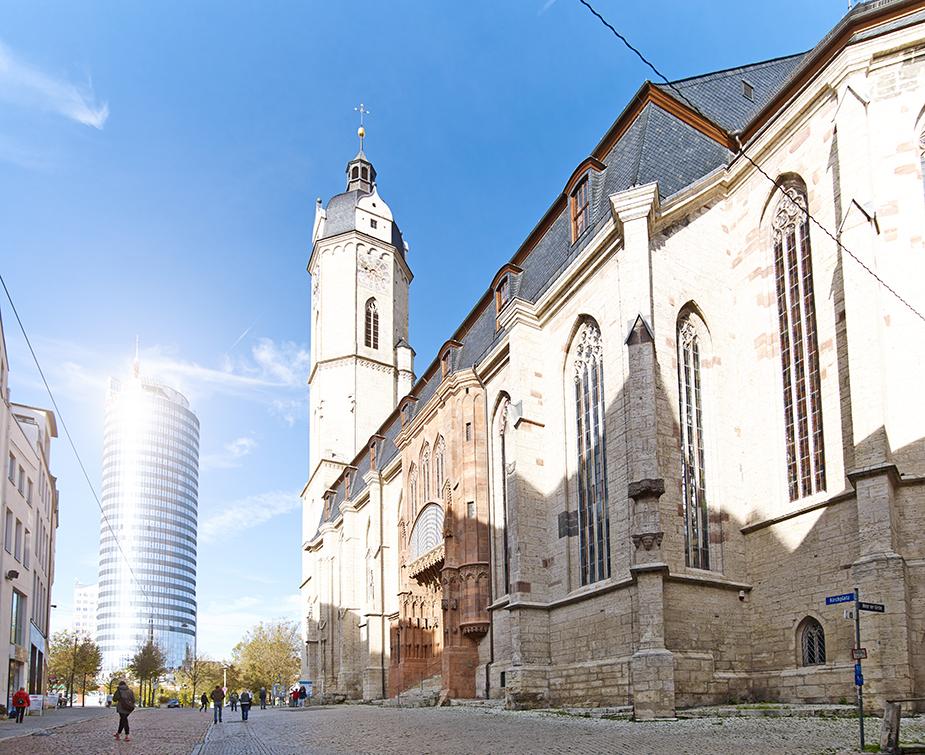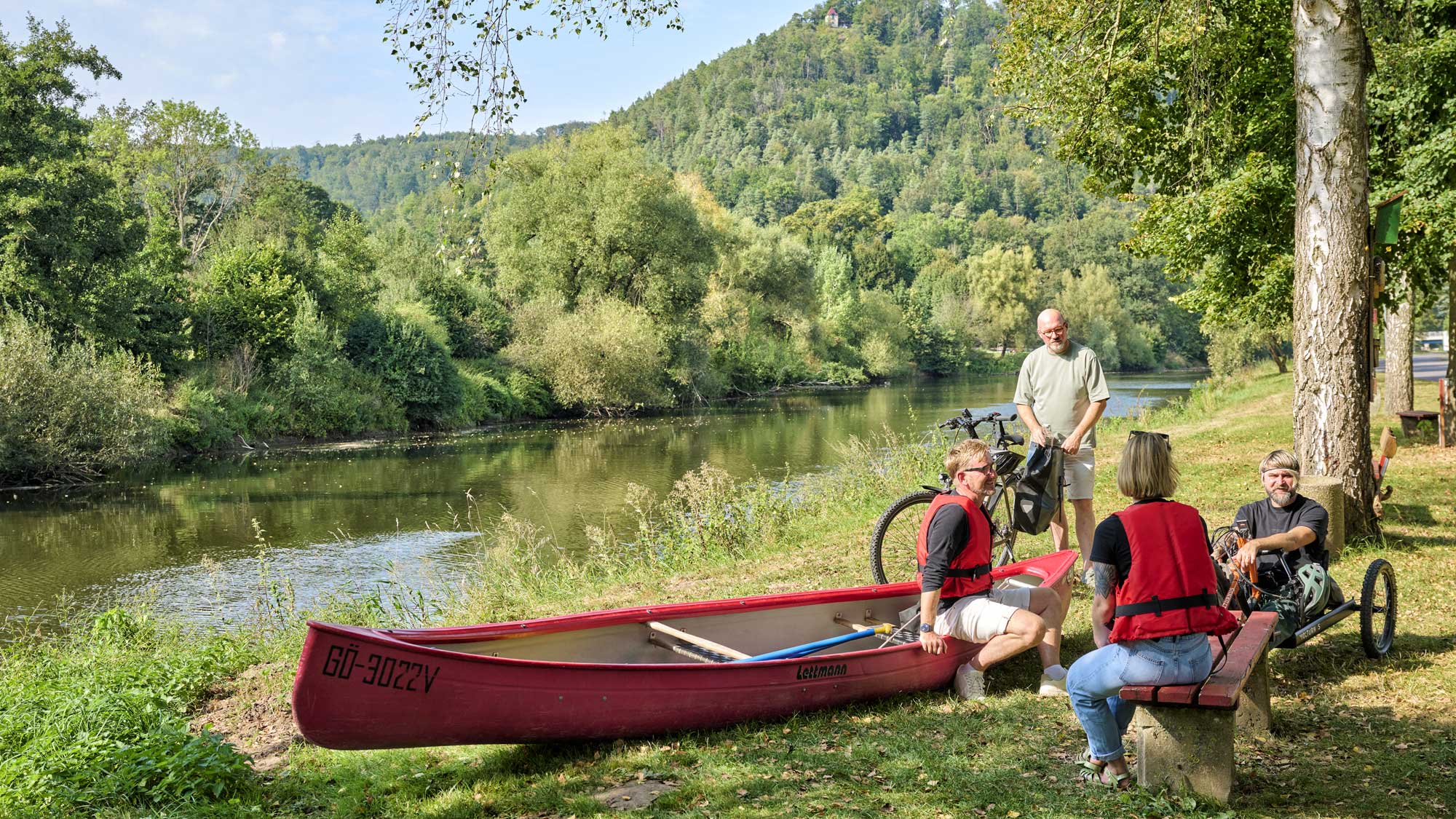You're in the right place! Whether in nature, in the middle of the city, for families, in the countryside, historic or traditional: among Thuringia's TOP hosts, everyone will find exactly the right address.
Words and places
Martin Luther’s Thuringian towns and cities
Erfurt: From student to monk
Martin Luther began to study in Erfurt in 1501 and entered the city’s Augustinian monastery in 1505. Important aspects of his theology and of the Reformation itself have their roots right here. In later years, Luther would recall an encounter in Erfurt when he was told: “A change has got to come, and it must be a great one; things cannot go on as they are.” When quoting this exchange in one of his ‘table talks’, Luther confidently stated: “And I do believe it did come to pass!” Indeed, the transformation from student to monk that Luther underwent in Erfurt did mark the beginning of one of the most profound and momentous upheavals in the history of the church.
Places associated with Luther in Erfurt include:
The Augustinian monastery and church: Luther knocked on the Augustinian friars’ gate on 17 July 1505.
Cathedral hill with St Mary’s Cathedral and St Severus church: After entering the Augustinian monastery, Luther was ordained as a priest in one of the cathedral chapels in April 1507. He also gave a lecture in the cathedral’s Auditorium Coelicum in 1509.
The Collegium Maius (main building of the university): This is where the great reformer enrolled in 1501 at the age of 17, as Martinus Ludher ex Mansfeldt. Luther’s matriculation record is probably the oldest existing document from his life. He successfully concluded his studies of the seven liberal arts in 1505 with a Magister Artium degree.
St Michael's church: In the Middle Ages, this church was used by the university, and Luther preached several sermons here.
The Georgenburse: Student lodgings near the Augustinian monastery where Martin Luther used to live while at university.
The Barfüßer church: Luther once preached at this church, which is still in use today despite being badly damaged in 1944.
The Merchants' Church with its Luther statue from 1899: Luther once preached at this church.
Eisenach and Wartburg Castle: “No other town knows me better”
Martin Luther’s relationship with Eisenach began when he went to school in the town in 1497, and it lasted for the rest of his life. Initially he was lodging with relatives and had to earn his own keep, which he did by joining a choir that sang door-to-door. Luther’s school stood south of St George’s Church until 1507. In 1501, Martin Luther left Eisenach to study in Erfurt. From 4 May 1521, he lived at Wartburg Castle for around 300 days. “Most of my relatives are in Eisenach, and I’m well known and respected there; no other town knows me better,” as he would put it later. But he also considered Eisenach to be “infested with priests”, which was not an unreasonable statement, given that one in ten of the population was a member of the clergy.
Places associated with Luther in Eisenach include:
Wartburg Castle, where Martin Luther translated the New Testament into German while being detained for his own protection,
St George's Church, where Luther the Latin student used to sing in the choir, and where Martin Luther the Reformer preached from the pulpit on several occasions.
The Luther House, now a museum. In around 1500, it was owned by the Cotta family, influential patricians who provided Martin Luther with lodgings while he attended school in Eisenach.
The Bachhaus, now a museum. Eisenach played an important role in the lives of both Martin Luther and Johann Sebastian Bach. Among his other accomplishments, Luther is Germany’s foremost author of Protestant church hymns, writing 38 in total, with Bach later setting at least 30 of them to music.
Schmalkalden: Luther and the Schmalkaldic League
During the Reformation, the town of Schmalkalden found itself right at the heart of European politics, when the Schmalkaldic League was founded there in 1530. Philip I, Landgrave of Hesse, was convinced that only an alliance of all Protestants could protect them against the Holy Roman Emperor. History recalls the assembly in the winter of 1537 as the ‘most glorious day of princes’. It was attended by 16 princes, six counts, envoys of the Emperor, of the Pope and of the kings of France and Denmark, representatives of 28 Imperial and Hanseatic cities, and 42 Protestant theologians, including Martin Luther, one of the pre-eminent and most popular scholars of the time. He carried with him the “articles by which I must stand, and will stand, until I die, as is God’s will, nor am I able to alter or concede anything therein”, as he wrote in a letter. From 1580 onwards, these articles of faith were incorporated into the Book of Concord of the Protestant church as the Schmalkaldic Articles.
Places associated with Luther in Schmalkalden include:
The Town hall: This is where the Schmalkaldic League was founded, and where it held its most important meetings from 1530 to 1543. The events of the 16th century are commemorated in the foyer of the town hall by the coats of arms of the League’s members and by the Luther bust created in 1996 by Wieland Förster.
The most eminent Protestant theologians preached in the Church of St George: in February and March 1537, including Martin Luther on two occasions. The former parament chamber now houses a small museum known as the Luther room.
The Luther House: Martin Luther stayed in this impressive timber-framed building during a visit to the town. Due to illness, he was forced to receive important callers here, and to preach sermons at the house.
Wilhelmsburg Castle: Topics covered by the permanent exhibition at the palace museum include the Reformation, Martin Luther and the Schmalkaldic League.
Weimar: “I am doing very well here!”
For Martin Luther, Weimar was a favourite stopover during his travels. But the town on the river Ilm was also a frequent destination in itself, as it was fertile ground for the ideas of the Reformation as well a place to discuss these ideas. Weimar had become part of the Ernestine dynasty’s territory in 1485. Under Duke John the Steadfast, the Reformation quickly took hold here, and the Ernestines made Weimar their new capital.
In 1540, five years before he died, the 57-year-old Luther wrote a letter from Weimar to his “beloved Kate, wife of Doctor Luther etc. … most humbly letting her know that I am doing very well here. I’m eating like a Bohemian and drinking like a German, thanks be to God, Amen.” Luther had been called to Weimar because Philipp Melanchthon (1497–1560), his closest friend and ally in the cause of the Reformation, was said to be on his deathbed. But then a ‘miracle’ happened, and the gravely ill patient made a full recovery.
Places associated with Luther in Weimar include:
The Church of St Peter & Paul (Herderkirche), where Luther preached sermons from the pulpit. The baptismal font and some chalices also date back to Luther’s time. The church’s winged altarpiece was begun by Lucas Cranach the Elder and completed by his son in 1555.
The Duchess Anna Amalia Library: Among its holdings is a unique Bible collection that includes a magnificent Luther Bible dating from 1534. Another precious item is the family register of Heinrich Kohlhans, bound in light-coloured pigskin leather, which includes inscriptions by Martin Luther, among others. A new Cranach exhibition (opens April 2022) features a portrait of Martin Luther as ‘Squire George’ painted in Wittenberg around 1522.
Weimar Palace: An earlier version of the palace church, the famous Himmelsburg (Castle of Heaven), was lost to a fire. Luther once preached at the palace.
The former Franciscan Monastery (Am Palais): Only parts of the monastery church where Martin Luther once preached remain today.
Jena: Taking Karlstadt to task
Martin Luther visited Jena at least eleven times between 1522 and 1537. The first occasion was a stopover on 3 March 1522, while he was staying at Wartburg Castle in the guise of ‘Squire George’, but needed to go to Wittenberg for a few days. His secret mission remained undiscovered. Also risky, and equally impossible to put off was Luther’s presence in Jena and other places in the Saale valley in August 1524, in matters relating to his former ally Andreas Bodenstein (1486–1541). Bodenstein, who also called himself Karlstadt, had abandoned Luther’s non-violent path of theological realignment and was prepared to support more drastic measures, as became evident through certain incidents at monasteries. In the packed Church of St Michael in Jena, Luther confronted ‘Karlstadt’, who was present, taking him to task in a 90-minute sermon, but this did not prevent the situation from escalating. Jena University was founded in 1558, as a – somewhat belated – offspring of the Reformation.

Martin Luther preached sermons at St Michael’s Church in Jena. ©Jens Hauspurg, Thüringer Tourismus GmbH
Places associated with Luther in Jena include:
The Church of St Michael: Luther preached several sermons from the 1500 pulpit, which is adorned with ornamental vines. Directly facing it is the great reformer’s memorial plate from the workshop of brass founder Johann Ziegler.
The Schwarzer Bär Hotel, where Luther stayed several times and where he often debated with students, as commemorated by a painting in the foyer.
The University library, which moved from Wittenberg to Jena in 1549. It houses precious printed works from the Reformation era, including Luther’s personal copies of the Old and New Testaments complete with his own handwritten annotations, as well as 35 volumes of writings by the theologian Georg Rörer.
Jena's municipal museum on the market square has an original Jena Luther Bible on display.
Thuringia also has a number of other sites that are directly linked to the Reformation and Martin Luther’s life and legacy in Thuringia through words, music or pictures.
These include the Ducal Museum in Gotha (Cranach galery), the Augustinan monastery in Gotha (where Luther also stayed and preached), die Church of St John in Neustadt/Orla (Cranach-altar), die Castle Church in Altenburg (where Luther preached), the Church St. Blaise in Nordhausen (where Luther preached), St Margaret's Church in Kahla (where Luther preached) and the Church of St John (where Luther preached) in Saalfeld.
The Luther Trail links the many Luther sites in Thuringia and also takes walkers past the state borders to Coburg in Bavaria and Torgau in Saxony. A new Luther Cycle Route features important Luther sites in Saxony-Anhalt, among them the towns of Eisleben and Wittenberg.
Header photo: Dawn breaks at Wartburg Castle. ©Christiane Würtenberger/cmr
Did you like this story?
Maybe, you'll like this too ...


























